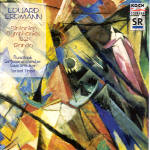Eduard Erdmann (1896-1958) made his reputation as a pianist more than as a composer. In the latter capacity, his career suffered from the post-War “Darmstadt” atonal revolution, and also perhaps from his membership in the Nazi party, though there apparently is no evidence that he regarded this as anything other than a means to find work and support himself during the Third Reich. Be that as it may, Erdmann was a composer of considerable substance. It’s a bit hard to describe his music, but if you can imagine a sort of more tonal and frankly melodic, less contrapuntally busy Karl Amadeus Hartmann, you might have a sense of what to expect.
The Rondo Op. 9, his first major orchestral work, evokes Strauss and Reger and makes a good-humored disc opener. Its somewhat stop-and-start thematic material gives no hint of the organic unity and structural mastery at work in both of the symphonies. Each of these two single-movement works evolves from its opening material with inexorable logic. The comparison with Hartmann becomes quite striking in the First Symphony, not so much in a melodic or rhythmic sense, but in the masterful orchestration (no inhibited Germanic grayness here!) and particularly in the way Erdmann constructs climaxes of tremendous power, always finding a way to screw the tension still higher just when you thought the music had reached its peak. The Second Symphony takes the process even further, revealing the composer’s confident handling of musical mass and texture (note the skillful way the music returns at times to the opening march-like motive) to create a large-scale movement that’s easy to follow, extremely dramatic and intense, but not in any way conventional or derivative.
As recent releases from Arte Nova and other German labels have demonstrated, the Saarbrücken Radio Symphony can produce excellent results, and it certainly does so here. Israel Yinon, conductor of so much interesting, forgotten repertoire leads them with a very clear sense of where this music is going and how to shape it for maximum effect. Good, clean recorded sound tops off a major discovery in the history of the German symphony in the early 20th century. So many discs purporting to uncover lost or neglected “masterpieces” turn out, after some initial pleasantries, to be disappointing on repetition. Here’s one with real staying power.
































